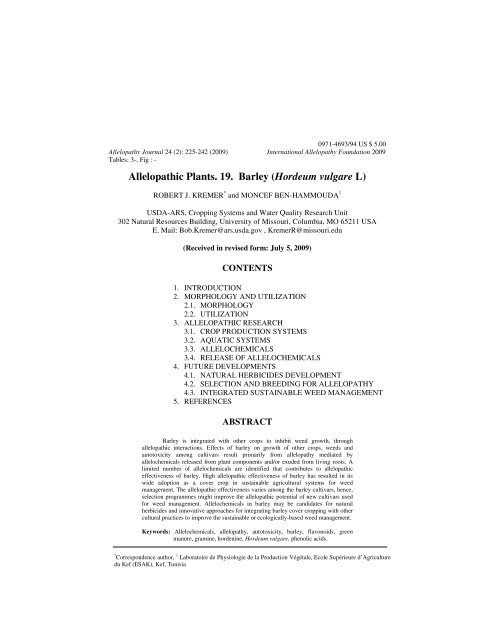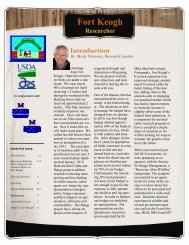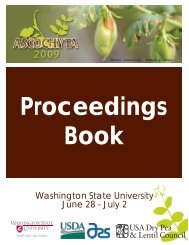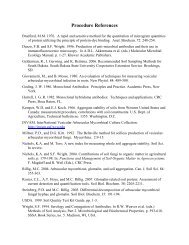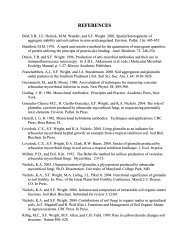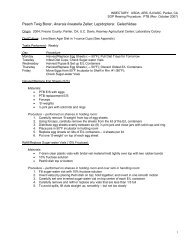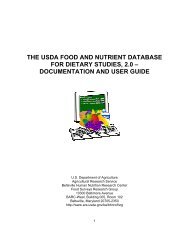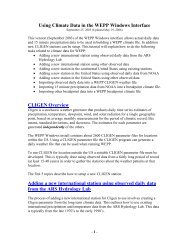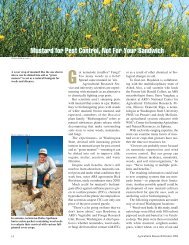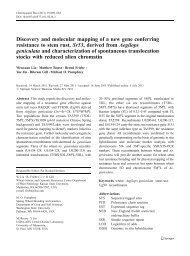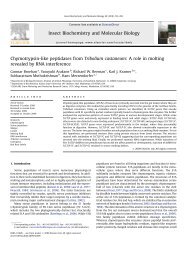Allelopathic Plants. 19. Barley (Hordeum vulgare L) - Agricultural ...
Allelopathic Plants. 19. Barley (Hordeum vulgare L) - Agricultural ...
Allelopathic Plants. 19. Barley (Hordeum vulgare L) - Agricultural ...
You also want an ePaper? Increase the reach of your titles
YUMPU automatically turns print PDFs into web optimized ePapers that Google loves.
0971-4693/94 US $ 5.00<br />
Allelopathy Journal 24 (2): 225-242 (2009) International Allelopathy Foundation 2009<br />
Tables: 3-, Fig : -<br />
<strong>Allelopathic</strong> <strong>Plants</strong>. <strong>19.</strong> <strong>Barley</strong> (<strong>Hordeum</strong> <strong>vulgare</strong> L)<br />
ROBERT J. KREMER * and MONCEF BEN-HAMMOUDA 1<br />
USDA-ARS, Cropping Systems and Water Quality Research Unit<br />
302 Natural Resources Building, University of Missouri, Columbia, MO 65211 USA<br />
E. Mail: Bob.Kremer@ars.usda.gov , KremerR@missouri.edu<br />
(Received in revised form: July 5, 2009)<br />
CONTENTS<br />
1. INTRODUCTION<br />
2. MORPHOLOGY AND UTILIZATION<br />
2.1. MORPHOLOGY<br />
2.2. UTILIZATION<br />
3. ALLELOPATHIC RESEARCH<br />
3.1. CROP PRODUCTION SYSTEMS<br />
3.2. AQUATIC SYSTEMS<br />
3.3. ALLELOCHEMICALS<br />
3.4. RELEASE OF ALLELOCHEMICALS<br />
4. FUTURE DEVELOPMENTS<br />
4.1. NATURAL HERBICIDES DEVELOPMENT<br />
4.2. SELECTION AND BREEDING FOR ALLELOPATHY<br />
4.3. INTEGRATED SUSTAINABLE WEED MANAGEMENT<br />
5. REFERENCES<br />
ABSTRACT<br />
<strong>Barley</strong> is integrated with other crops to inhibit weed growth, through<br />
allelopathic interactions. Effects of barley on growth of other crops, weeds and<br />
autotoxicity among cultivars result primarily from allelopathy mediated by<br />
allelochemicals released from plant components and/or exuded from living roots. A<br />
limited number of allelochemicals are identified that contributes to allelopathic<br />
effectiveness of barley. High allelopathic effectiveness of barley has resulted in its<br />
wide adoption as a cover crop in sustainable agricultural systems for weed<br />
management. The allelopathic effectiveness varies among the barley cultivars, hence,<br />
selection programmes might improve the allelopathic potential of new cultivars used<br />
for weed management. Allelochemicals in barley may be candidates for natural<br />
herbicides and innovative approaches for integrating barley cover cropping with other<br />
cultural practices to improve the sustainable or ecologically-based weed management.<br />
Keywords: Allelochemicals, allelopathy, autotoxicity, barley, flavonoids, green<br />
manure, gramine, hordenine, <strong>Hordeum</strong> <strong>vulgare</strong>, phenolic acids.<br />
* Correspondence author, 1 Laboratoire de Physiologie de la Production Végétale, Ecole Supérieure d’Agriculture<br />
du Kef (ESAK), Kef, Tunisia
226<br />
Kremer and Ben-Hammouda<br />
1. INTRODUCTION<br />
<strong>Hordeum</strong> <strong>vulgare</strong> L. (barley) is one of three species of genus <strong>Hordeum</strong> belonging<br />
to the tribe Triticeae of Poaceae family (89). Its Cultivation as domestic food crop started<br />
in the beginning of agriculture 10,000 years ago (26,73). It has originated in the Fertile<br />
Crescent [Israel, Jordan, Syria and southern Turkey to Zagros Mountains in Iran (59,89)].<br />
During the early development of agriculture, barley was a staple food in bread-making and<br />
in soup and porridge dishes, However later, it became a multi-purpose crop [livestock<br />
feed, malt for brewing alcoholic beverages, pasture for grazing livestock, hay and silage<br />
for feeding livestock] and as a cover crop in rotation with cash crops, to reduce soil<br />
erosion, improve soil tilth and suppress weeds. It is adapted to a broad range of ecological<br />
conditions but grows best in temperate climates of cool and moderately dry seasons (73).<br />
Its early maturity characteristic, due to a low heat unit requirement, allows barley to be<br />
successfully cultivated at high latitudes of Alaska, Scandinavian countries, Tibet and<br />
Ethiopia, where the summers are too cool or too short to grow other cereals (73). In the<br />
Northern Hemisphere, spring barley, the most widely grown type planted in regions above<br />
latitude 40°N from March through June, is the primary source of malt and food grain.<br />
Below latitude 40°N, winter types are planted from mid-September through October,<br />
which allows the crop to be used for both pasture and feed grain production or for hay and<br />
silage (72,73). The global area devoted to barley production is about 65 million ha with<br />
75% of the area in Europe, North Africa and western and southwestern Asia; North<br />
America contributes to about 10% of the area (26).<br />
2. GENERAL CHARACTERISTICS AND UTILIZATION<br />
2.1. MORPHOLOGY<br />
<strong>Barley</strong> is an annual herbaceous monocotyledonous grass. During germination the<br />
barley caryopsis develops seedling roots followed by emergence of a coleoptile through<br />
the soil surface (79). Seminal roots develop after germination, growing outward and<br />
downward, forming a fibrous, branched root system. Internodes developing between the<br />
coleoptile and the first leaf form the crown from which the adventitious, or nodal, roots<br />
develop to help anchor the plant. When the plant reaches the six-leaf growth stage, 10 to<br />
17 roots may be present reaching a depth of 45 to 60 cm, depending on soil characteristics,<br />
moisture and nutrient availability and may attain a depth of >1 m at maturity (79). Stems<br />
are cylindrical consisting of hollow internodes separated by solid nodes (joints), which are<br />
the origins of the leaf sheaths and range from 70 cm for dwarf types to >150 cm in length<br />
(79). Multiple stems (tillers) developed per plant depends on stand density and cultivar<br />
genetics and may number from one to six stems. Tillering is important in determining<br />
yield potential and compensation for variable plant densities. The inflorescence of a barley<br />
plant is a spike (head or ear) at the top of the stem, consisting of either two or six rows of<br />
fertile spikelets, in which the mature caryopses develop (79).<br />
2.2. UTILIZATION<br />
Approximately 85% of current world barley grain production is used as livestock<br />
feed (26,73) followed by malt for brewing beer and certain whiskeys (26). <strong>Barley</strong> is used
<strong>Allelopathic</strong> <strong>Hordeum</strong> <strong>vulgare</strong><br />
as a food in those regions where other cereal crops do not grow (50). Its other food uses<br />
are breakfast cereals, bread flour and pearled barley as a soup thickener.<br />
Winter barley is a versatile on-farm crop as a source of ample fall and winter<br />
pasture for grazing livestock and of feed grain after harvest of mature crop. The straw<br />
remaining after barley grain harvest is used for feeding ruminant livestock as well as for<br />
bedding in stables and feedlots. <strong>Barley</strong> is well-suited for rotations with other crops, as a<br />
nurse crop for establishment of long-term stands of grasses or legume forages such as<br />
alfalfa (Medicago sativa L.) and as an overwintering cover crop for protection against soil<br />
erosion (72). Recent research demonstrated that barley intercropped with berseem or<br />
Egyptian clover (Trifolium alexandrinum L.) provided high quality forage with high<br />
protein content for feeding livestock (87). The effectiveness of barley as a cover crop for<br />
suppressing weed infestations (4, 13) and as an amendment to water impoundments to<br />
inhibit algae (29,95) is due to allelopathic effects.<br />
3. ALLELOPATHIC RESEARCH<br />
3.1. CROP PRODUCTION SYSTEMS<br />
Allelopathy in barley may be manifested to other crops (“crop allelopathy”) when<br />
grown in various management systems, as autotoxic effects among certain barley cultivars,<br />
or toward various weed species.<br />
3.1.1. Crop rotation: A limited number of studies that demonstrate allelopathic effects of<br />
barley to other crops were based on field observations of poor growth of crops planted into<br />
soil previously planted to barley in a crop rotation scheme. Field studies in Canada found<br />
that flax (Linum usitatissimum L.) growth was inhibited when grown in soils containing<br />
barley crop residues (34). Small-seeded crops were particularly susceptible to allelopathy,<br />
demonstrated by field studies of spring and winter barley residues on the soil surface in<br />
which germination and growth of lettuce (Lactuca sativa L.), cabbage (Brassica oleracea<br />
L.) and tomato (Lycopersicon esculentum Mill.) were severely reduced (76,77). Poor<br />
growth of bread wheat (Triticum aestivum L.) and durum wheat (Triticum durum L.)<br />
observed when grown in a rotation sequence after winter barley in Tunisia was shown in<br />
laboratory assays to be due to seedling growth inhibition by residues of barley (10).<br />
3.1.2. Crop mixture/intercropping: Indications for growth interference other than<br />
competition are reported when clover (Trifolium sp.) growth was reduced by >50% when<br />
inter-planted with barley under abundant soil water and nutrients (56). Seedlings of<br />
numerous barley cultivars from a large germplasm collection inhibited seedling growth of<br />
perennial ryegrass (Lolium perenne L.) when grown together in an agar bioassay (13).<br />
Aqueous extracts of vegetative residues of spring barley inhibited seedling root growth of<br />
alfalfa (Medicago sativa L.) and radish (Raphanus sativa L.) in laboratory assays (78).<br />
Aqueous extraction of vegetative residues to assay for allelopathy suggested that<br />
allelochemicals were directly released from plant tissues rather than as a result of<br />
decomposition (76). Using a hydroponics growth system and a ‘siphoning’ bioassay<br />
apparatus, Liu and Lovett (49) demonstrated that allelochemicals directly released from<br />
227
228<br />
Kremer and Ben-Hammouda<br />
barley seeds and seedling roots delayed germination and severely inhibited seedling<br />
growth of white mustard (Sinapsis alba L.).<br />
3.1.3. Autotoxicity: Autotoxicity is defined as poor growth of a crop planted into soils<br />
continuously planted to the same crop (78). This is observable as decreased germination or<br />
seedling development by water extracts of the same crop residues, suggesting an<br />
interspecific form of allelopathy (78,80). Certain winter barley cultivars were found to be<br />
autotoxic, first illustrated by the inhibition of coleoptile and radical growth of the sensitive<br />
barley cultivar ‘Manel’ by the allelopathic cultivar ‘Rihane’ (11). <strong>Barley</strong> plant components<br />
grown under adverse environmental conditions, especially drought stress, increased the<br />
severity of allelopathic effects in the autotoxic response (63). Allelochemicals involved in<br />
autotoxicity included a combination of phenolic acids, which varied seasonally in plant<br />
content depending on environmental conditions (64). The practical implications of the<br />
research on autotoxicity include recognition of barley as a high-allelopathic risk in barleybarley<br />
cropping sequences, especially in semi-arid regions, information useful in decisionmaking<br />
by producers when selecting barley cultivars for planting in cereal crop rotations.<br />
3.1.4. Weed suppression: Suppression of weed growth by barley and other plants was<br />
noted over 2000 years ago; the relationship of weed suppression to chemical substances<br />
released from these crops and the first description of this process as allelopathy developed<br />
during the 1800’s and early 1900’s (2,75,96). Only within the last 45 years has the<br />
deliberate exploitation of allelopathy for weed management been intensively pursued. The<br />
use of “cover crops” (crops planted during phases when main crops are absent and fields<br />
are otherwise fallow) takes advantage of allelopathic properties to manage weeds without<br />
inputs of synthetic herbicides. <strong>Barley</strong> is particularly effective as a cover crop for use in<br />
weed management because it rapidly establishes under a wide range of soil and<br />
environmental conditions and quickly grows to shade out weeds in addition to releasing<br />
allelochemicals to suppress weed growth (16). Early studies of the effects of barley as a<br />
“smother crop” for suppressing weed growth found that substances released from the<br />
foliage contained allelopathic activity responsible for severely inhibiting growth of<br />
chickweed (Stellaria media L.) (66). Several laboratory or growth chamber studies have<br />
demonstrated allelopathic effects of extracts of barley plants on seed germination and<br />
seedling growth of numerous weed species (17,20,52,65). Although growth reduction of<br />
weedy Brassica species under irrigated field conditions was largely due to superior<br />
competitiveness of barley for light and nitrogen, allelopathy as a component of overall<br />
interference could not be excluded (47). In field studies under no-tillage, spring barley<br />
residues reduced weed densities by ≤90% compared with soils devoid of surface residues<br />
(77). Subsequent studies confirmed the effectiveness of barley residues in reducing plant<br />
densities of the weeds portulaca (Portulaca oleracea L.) and smooth crabgrass [Digitaria<br />
ischaemum (Schreb.) Muhl.] 60 days after killing the barley with paraquat (76). <strong>Barley</strong><br />
residues added to the soil surface of field plots inhibited emergence of eastern black<br />
nightshade (Solanum ptycanthum Dun.) by 98% and yellow foxtail [Setaria glauca (L.)<br />
Beauv.] by 81% 30 days after planting the weed species (19). <strong>Barley</strong> grown in rotation<br />
with wheat provided an apparent residual weed control observed in the wheat crop for ≤ 2<br />
years (46). The allelopathic potential of several barley cultivars was detected by wild
<strong>Allelopathic</strong> <strong>Hordeum</strong> <strong>vulgare</strong><br />
mustard (Sinapsis arvensis L.), a sensitive test species for detecting germination and<br />
seedling growth inhibition differences among the cultivars (65).<br />
3.2. AQUATIC SYSTEMS<br />
Addition of barley straw to aquatic sites including lakes and waterways is a<br />
sustainable approach to reduce the growth of undesirable algae in water due to<br />
eutrophication. This allelopathic effect of barley against filamentous algae was observed in<br />
1980, when rotting barley straw in a canal in England reduced the density of floating algae<br />
(95). Subsequent laboratory studies demonstrated that the inhibitory substances were<br />
released from the straw during leaching by water (29). This finding has implications for<br />
sustainable use of a natural product (barley straw) to control algae in sensitive aquatic<br />
systems, where herbicides use is not environmentally acceptable.<br />
3.3. ALLELOCHEMICALS<br />
Generally characterization of chemical constituents have focussed on effects on<br />
forage and feed quality, malting properties and insect and disease resistance, etc. Despite<br />
the widespread use of barley for weed suppression, little research has been conducted on<br />
the nature of allelochemicals in barley (6). Till now only 44 chemicals have been<br />
identified as potential allelochemicals that contribute to its allelopathic activity (Table 1).<br />
Table 1. Allelochemicals identified in <strong>Hordeum</strong> <strong>vulgare</strong><br />
Compound<br />
A. Alkaloids<br />
Plant component References<br />
Gramine (N,Ndimethylindolemethyl-amine)<br />
Leaf, Root, Root exudate 35,36,40,50,100<br />
Hordenine (N,N-dimethyltriamine) Leaf, Root, Root exudate 40,50,53,56<br />
B. Phenolic Acids, Phenolic Acid Derivatives<br />
(a) Phenolic acids<br />
Benzoic acid Root exudate 2<br />
Caffeic acid Leaf, Seed, Stem, Root exudate 2,17,101<br />
Chlorogenic acid Leaf, Seed 41,101<br />
m-Coumaric acid Leaf, Stem 17<br />
o-Coumaric acid Leaf, Stem, Root exudate 2,17<br />
p-Coumaric acid Leaf, Seed, Stem, Root exudate 15,17,41,61,64,101<br />
Coumarin Leaf, Stem 17<br />
Ferulic acid Leaf, Seed, Stem, Root, Root<br />
exudate<br />
2,5,41,51,61,64,101<br />
Gentisic acid Root exudate 2<br />
Hydroxycinnamic acid Leaf, Stem 17,51<br />
p-Hydroxybenzoic acid Leaf, Seed, Stem, Root, Root 2,15,64,101<br />
exudate<br />
5-Hydroxyferulic acid Leaf 61<br />
Protocatechuic acid Leaf, Seed 41,101<br />
Salicylic acid Leaf 41<br />
Sinapic acid Leaf 61<br />
Syringic acid Leaf, Seed, Stem, Root 64<br />
Trans-cinnamic acid Leaf, Root exudate 2,41<br />
Vanillic acid Leaf, Seed, Stem, Root, Root<br />
exudate<br />
2,15,41,64,101<br />
229
230<br />
Kremer and Ben-Hammouda<br />
(b) Phenolic acid derivative<br />
Scopoletin Root exudate 2<br />
C. Flavonoids<br />
Apiginen Leaf 38<br />
Lutonarin Leaf 51<br />
Saponarin Leaf 51<br />
Cyanadin Leaf 37<br />
Isovitexin Leaf 62<br />
Lutonarin 3’-methyl ether Leaf 82<br />
Catechin Seed 28<br />
D. Cyanoglucosides<br />
Heterodendrin Leaf 24<br />
Epiheterodendrin Leaf 24,60,74<br />
Epidermin Leaf 60,74<br />
Sutherlandin Leaf 60,74<br />
Osmaronin Leaf 60<br />
Dihydroosmaronin Leaf 60<br />
3-ß-D-glucopyranosyloxy-3methylbutyronitrile<br />
Leaf 74<br />
1-cyano-3-ß-D-glucopyranosyloxy- Leaf 74<br />
2-methylpropene<br />
4--D-glucopyranosyloxy-3hydroxy-3-hydroxymethylbutyronitrile<br />
Leaf 74<br />
E. Polyamines<br />
Hordatine A & B Leaf 84<br />
Putresceine Leaf 92<br />
Spermidine Leaf 32,92<br />
Spermine Leaf 92<br />
p-Coumaroylagmatine Leaf 85<br />
F. Hydroxamic Acids<br />
2,4-dihydroxy-1,4-benzoxazin-3one<br />
(DIBOA) 1<br />
1 Detected in wild <strong>Hordeum</strong> spp. only<br />
Leaf 3, 33<br />
3.3.1 Alkaloids hordenine and gramine: The alkaloids hordenine and gramine were<br />
reported 70 years ago (57,66). Although their wide biocidal activity against<br />
microorganisms and insects was known (18,98; Table 2), the phytotoxicity of gramine was<br />
not established until 1966 (66) and of hordenine until 1989 (53). Thereafter these alkaloids<br />
have since become the premier allelochemicals for explaining the allelopathic effects of<br />
barley (6). Demonstration of allelopathy using the purified compounds has been limited to
<strong>Allelopathic</strong> <strong>Hordeum</strong> <strong>vulgare</strong><br />
231
232<br />
Kremer and Ben-Hammouda
<strong>Allelopathic</strong> <strong>Hordeum</strong> <strong>vulgare</strong><br />
indicator species of chickweed (66) and white mustard (49,50). Physiological effects of<br />
gramine and hordenine on susceptible plants include cell wall damage, increased cell<br />
vacuolation, damage to mitochondrial structure and disruption in cellular metabolism (50).<br />
When both alkaloids were combined and assayed on white mustard, the cellular damage<br />
increased, demonstrating a synergistic effect of gramine and hordenine. Gramine and<br />
hordenine concentrations in the barley plant vary among cultivars (35,36,40) and with<br />
environmental conditions [moisture, temperature and light intensity stresses (36)].<br />
Increased allelochemical production due to exposure to environmental stress occurs in<br />
several plant species (22); thus, allelopathic effectiveness based on gramine and hordenine<br />
production of different barley cultivars grown under various environmental conditions<br />
may also be affected.<br />
3.3.2. Phenolic compounds: Phenolic compounds contribute the greatest number of<br />
allelochemical compounds in barley, about 43%, all but one of which are phenolic acids.<br />
Phenolic acids occur widely in plants and influence many metabolic activities including<br />
the ability to modulate key cellular enzyme functions (101). Phenolic acids are also<br />
implicated in the expression of allelopathic activity by many plant species (4). In a survey<br />
of spring cereal crops varieties, Baghestani et al. (2) identified seven phenolic acids and<br />
one phenolic acid derivative (Table 1) released with root exudates of barley. Three<br />
phenolic compounds, (o-coumaric acid, vanillic acid and scopoletin) were more abundant<br />
in root exudates of “highly competitive” cultivars and were considered indicators of<br />
allelopathic potential and as contributors to overall competitiveness, traits that would be<br />
useful in breeding programmes for varietal selection. Bioassays of phenolic acids<br />
associated with barley foliage showed that salicylic acid, vanillic acid, p-coumaric acid,<br />
ferulic acid and chlorogenic acids possessed moderate to high allelopathic efficiency in<br />
growth inhibition of barnyardgrass [Echinochloa crus-galli (L.) P. Beauv.], suggesting a<br />
high potential for these compounds in herbicide development (41). Five phenolic acids (pcoumaric<br />
acid, ferulic acid, p-hydroxybenzoic acid, syringic acid, vanillic acid) were<br />
detected in several components of barley that contributed to autotoxicity (64). The barley<br />
variety and weather conditions during the growing season affected the concentrations of<br />
phenolic acids in plant parts (63,64). In bioassays, the combinations of phenolic acids<br />
often show synergistic effects (9,22), showing high overall allelopathic or autotoxic<br />
activity in those barley cultivars that produce numerous phenolic acids (2,64).<br />
Morphological and physiological effects of phenolic acids on susceptible plants are:<br />
reduced leaf expansion, leaf production, net carbon assimilation rate and stomatal<br />
conductance (68); decreased leaf water potential due to reduced osmotic potential and<br />
turgor pressure (23) and lower nutrient contents in roots and shoots (23).<br />
3.3.3. Flavonoids: Flavonoids, phenylpropanoid compounds synthesized through the<br />
shikimate pathway (12,80), are widespread in plants and ecologically important as<br />
pigments, attractants, herbivore deterrents, and allelochemicals (37,80). Many biochemical<br />
investigations of barley reveal a rich source of flavonoids with biological activity,<br />
however, little is known about the function of these compounds, especially allelopathic<br />
activity. Because a limited number of flavonoids associated with other plants are directly<br />
involved in allelopathic interactions (12,55,80), flavonoids identified in barley are<br />
presented to indicate their potential contribution to overall allelopathiy of barley (Tables 1<br />
233
234<br />
Kremer and Ben-Hammouda<br />
and 2). In barley, unique flavonoids including lutonarin, saponarin and isovitexin are<br />
localized in the epidermis and mesophyll tissue of leaves and accumulate in response to<br />
exposure to high levels of ultraviolet (UV) radiation thereby protecting the plant from<br />
peroxidative damage (51,62). Recent research showing that UV-absorbing flavonoids in<br />
cotton (Gossypium hirsutum L.) leaf tissue contribute to a defense mechanism against the<br />
bacterial phytopathogen Xanthomonas campestris (21) suggests that a similar mechanism<br />
may function in barley. Other common flavonoids often implicated in allelopathic activity<br />
of many plants detected in barley include cyanidin (37) and catechin (28,55). The<br />
mechanisms of potential allelopathy by flavonoids include inhibition of germination and<br />
cell growth, disruption of adenosine triphosphate (ATP) formation, and interference with<br />
plant growth regulator (i.e., auxin) function (12).<br />
3.3.4. Cyanogenic glycosides: The major form of cyanogenic glycosides found in barley<br />
is cyanoglucoside derived from the amino acid leucine and glucose (60). Hydrogen<br />
cyanide (HCN) may be released from cyanoglucosides and exert toxic effects toward other<br />
plants and pathogens; thus the presence of these compounds in barley suggests a potential<br />
allelopathic and pathogen defense system. Hydrogen cyanide is a potent inhibitor of<br />
electron transport in photosynthesis and respiration pathways (97). The release of HCN<br />
from barley leaf extracts has been observed, most likely derived from epiheterodendrin<br />
(27), however a linkage of HCN production with allelopathy was not demonstrated.<br />
Further complicating a defined role for cyanoglucosides was the observation that<br />
epidermin, epiheterodendrin and heterodendrin may be degraded by the phytopathogenic<br />
fungus Erysiphe graminis during infection and used as a carbohydrate source (74).<br />
Cyanoglucosides are sequestered away from enzymes necessary for degradation in a<br />
highly compartmentalized arrangement within the barley leaf; thus very limited amounts<br />
of HCN are released (27,60). Considerable additional research is necessary to determine<br />
the allelopathic potential of the cyanoglucosides present in barley.<br />
3.3.5. Polyamines: The polyamines are compounds possessing two or more primary<br />
amino groups and found widely throughout the Plantae phylogenetic group (91).<br />
Polyamine concentrations in plants increase in response to various stress factors including<br />
drought, salinity, and pathogen infection (91). Concentrations of several polyamines<br />
including putrescine, spermine, spermidine, coumaroylagmatine, and hordetine in barley<br />
increase greatly when challenged with powdery mildew (91,92), brown rust (32), and foot<br />
rot fungal pathogens (85) and exhibit significant antifungal activity (Table 2). Polyamines<br />
tend to increase in leaf tissue surrounding the fungal infection to isolate the pathogen and<br />
suppress the spread of the disease (91). The impact of polyamines on weeds or insects has<br />
not been investigated.<br />
3.3.6. Other compounds: The large number and diversity of plant-derived chemicals in<br />
nature suggests that many novel allelochemicals of barley remains to be discovered (96).<br />
For example, the detection of the hydroxamic acid DIBOA (Table 1) in wild <strong>Hordeum</strong><br />
spp. (3,33) indicates the potential to discover it in domestic barley through screening of a<br />
global germplasm collection of barley cultivars. Numerous metabolites of barley have<br />
been described based on analyses for properties unrelated to allelopathy (i.e., malting) yet<br />
might be potential allelochemicals. For example, polyphenols detected in barley grain
<strong>Allelopathic</strong> <strong>Hordeum</strong> <strong>vulgare</strong><br />
undergoing routine analyses for brewing quality (7), might contribute to allelopathy<br />
exhibited by barley seeds, which inhibited the growth of white mustard seedlings in<br />
bioassays (49).<br />
3.4. RELEASE OF ALLELOCHEMICALS<br />
An understanding of the modes of release of allelochemicals from the plant into<br />
the environment is important to develop effective cultural practices that exploit the<br />
allelopathic activity of crops as a successful weed management strategy (30,94). The<br />
primary modes of entry include exudation, leaching, decomposition and volatilization<br />
(1,52,80). In barley, gramine and hordenine are actively exuded from roots (beginning at<br />
the seedling growth stage and continues for at least 75 days); during this period the growth<br />
of competing weed species may be suppressed (52). Numerous phenolic acids are exuded<br />
through roots into the rhizosphere and adjacent soil, these are presumed to provide barley a<br />
competitive advantage over nearby growing plant species (2,15,86).<br />
3.4.1. Allelochemicals in aqueous phase: Allelochemicals can be leached from the<br />
living plant during precipitation (rainfall, snow, dew, mist etc.) (100) and mulching of<br />
fresh residues on the soil surface or incorporated into soil, as evident from the detection of<br />
numerous compounds in water extracts from all parts of barley plant (15,17,52,64). The<br />
release of water-soluble allelochemicals from vegetative components is thought to be the<br />
primary factor contributing to the overall weed suppressive effect of barley used as a cover<br />
crop, mulch, or “smother crop” in crop production systems (17,20,66,76). In allelopathic<br />
mulch of barley residues, allelochemicals are most concentrated near the soil surface<br />
creating an “allelopathic zone” in which germination and/or seedling growth of smallseeded<br />
weeds are suppressed (48). Substances that may be allelopathic include those<br />
released during decomposition of fresh barley plant residues or mature straw directly into<br />
soil or aquatic ecosystems (30,52,95). The complexity of soil environment and the resident<br />
microbial community confounds the detection of specific decomposition products<br />
responsible for allelopathic effects of incorporated barley residues (6,52), although several<br />
organic acids formed during the decomposition under high soil moisture are often<br />
implicated in phytotoxicity to seedlings (52,54).<br />
3.4.2. Allelochemicals in vapor phase: Release of volatile phytochemicals from intact<br />
barley plants at the V2 growth staged depressed the feeding preference of aphids<br />
(Rhopalosiphum padi) on adjacent barley host plants, suggesting that plants facilitate a<br />
biochemical signaling system to induce defence mechanisms prior to attack by plant<br />
herbivores (31,70). These findings suggest an interesting potential of barley for weed<br />
suppression in all barely growing regions. Indeed Belz (6) suggests that certain barley<br />
varieties might be selected with the ability to sense the competitive weeds and signal<br />
neighboring barley plants through volatile or rhizosphere compounds to induce<br />
biosynthesis of allelochemicals to suppress such invading weeds. Such biotic induction<br />
exists in rice (Oryza sativa L.) toward barnyard grass and sorghum [Sorghum bicolor (L.)<br />
Moench] toward velvetleaf (Abutilon theophrasti Medik.) (6). Volatile substances may not<br />
only affect the weeds growing in barley crop, but may also suppress the weed seedlings<br />
immediately after the soil incorporation of residues.<br />
235
236<br />
Kremer and Ben-Hammouda<br />
4. FUTURE DEVELOPMENTS<br />
Although a limited number of allelochemicals have been characterized for barley,<br />
future efforts to exploit the allelopathic properties of barley in weed management may<br />
involve basic research on allelochemical structure and mode of action needed for potential<br />
herbicide development; selection and breeding programmes for optimum allelopathic<br />
activity and integration of barley allelopathy with other weed control methods.<br />
<strong>Allelopathic</strong> suppression of weeds and other pests using crops such as barley may be most<br />
effective as a component in a multi-faceted management system rather than as a single<br />
tactic approach (39). Potential strategies for exploiting barley allelopathy in weed<br />
management are presented in Table 3.<br />
4.1. NATURAL HERBICIDE DEVELOPMENT<br />
Continued isolation and identification of compounds implicated in allelopathy has<br />
been emphasized as a major research effort to develop natural herbicides or growth<br />
regulators that may possess novel modes of action and therefore, may more be effective<br />
than many current herbicides to which weeds have developed resistance (75,96). A<br />
precedent use of barley allelochemicals in pest management was suggested for gramine<br />
application to cereal crop foliage to control powdery mildew (98). It is also critical to<br />
consider the total complex of allelochemicals in the barley plant due to synergistic effects<br />
on weed growth (22,41). Information on allelochemical concentrations and combinations<br />
is necessary for the potential development of effective natural chemical-based herbicides.<br />
4.2. SELECTION AND BREEDING FOR ALLELOPATHY<br />
The wild populations, accessions and cultivars of crops differ in allelopathic traits<br />
and in the related resistance to pests. Weih (94) suggests that allelopathic activity is<br />
particularly high in cereal crops and should be used as an effective selection criterion in<br />
breeding programmes to enhance the competitive ability. Wild accessions and older<br />
cultivars of barley are more resistant to weed interference, traits that may have<br />
unintentionally been lost during selection of many modern cultivars (2,4,13,40,52).<br />
Potential for selection of allelopathic traits in barley is demonstrated in a study reporting<br />
that allelopathic activity of several barley cultivars was responsible for 7 - 58% of the<br />
observed weed suppressive effects (14). A subsequent study identified the barley cultivar<br />
‘Athinaida’ as most allelopathic cereal crops to suppress the growth of barnyardgrass and<br />
bristly foxtail [Setaria verticillata (L.) P. Beauv.] and increasing the grain and silage<br />
yields of maize (Zea mays L.) planted into the barley mulch (17). A few examples from<br />
other cereal crops demonstrate the potential for selection of “allelopathic germplasm.”<br />
Evaluation of 3000 accessions of oat (Avena sativa L.) germplasm, found 25 accessions<br />
with significantly higher scopoletin than the standard cultivar ‘Garry’ (25). A rye (Secale<br />
cereale L.) cultivar, ‘Forrajero-Baer’, was selected for high production of hydroxamic<br />
acids in root exudates, which reduced weed growth in the field by 83 and 76% compared<br />
to wheat or oats, respectively (69). Use of barley wild types as sources of allelopathic<br />
potential may be necessary because these plants are evolved in the allelopathic and<br />
competitive environments of other plant species (75). Because allelochemical production<br />
in a plant is believed to be under genetic control, a breeding programme could be initiated
<strong>Allelopathic</strong> <strong>Hordeum</strong> <strong>vulgare</strong><br />
to transfer allelopathic genes into modern cultivars to enhance the allelopathic activity<br />
(4,6,99). Alternatively, genes encoding for allelopathic traits from other plant sources<br />
could be inserted into barley as well as other major crops using genetic modification<br />
techniques (6,96) including development of transgenic cultivars with allelopathic traits (5).<br />
A need exists for cultivars with consistent performance in expressing allelopathy<br />
especially in sustainable agricultural systems and in environmentally-sensitive areas,<br />
where herbicides are restricted or banned (13).<br />
4.3. INTEGRATED SUSTAINABLE WEED MANAGEMENT<br />
Integrated sustainable weed management rely on many available strategies (Table<br />
3) to reduce weed seed banks, prevent weed emergence and minimize the competition of<br />
weeds with growing crop (1). Integrating barley into a crop rotation sequence provided<br />
‘residual effects’ in soil, likely due to release and persistence of allelochemicals, that<br />
reduced weed infestations in subsequent wheat crops grown during the following two<br />
years (46). Cover crops including barley will remain important components in ecological<br />
or biological weed management, which involves the use of various biological approaches<br />
including allelopathy, bioherbicides, crop competition and other cultural practices such as<br />
reduced tillage to obtain dramatic reductions in weed infestations similar to those that may<br />
be realized with herbicides (8,45). <strong>Barley</strong> included in combinations with other grass and<br />
legume cover crop species contributes to a wider range of allelochemicals released into<br />
soil and thereby broadens the spectrum of weed control (16). <strong>Barley</strong> seed inoculated with<br />
bacterial bioherbicide preparations delivered the bioherbicidal bacteria into soil at planting<br />
which allowed colonization of developing weed seedling roots and eventual weed growth<br />
inhibition (44). The combined effects of the bacterial bioherbicide and allelopathy of<br />
barley plant residues suppressed the growth of numerous weeds. <strong>Barley</strong> combined with<br />
Vicia faba L. reduced the weed biomass production by 47 – 85% more than with pure<br />
stands of either crop species (30). Also, a systems approach where an inter-seeded cover<br />
crop with a row crop is treated with a post-emergence bioherbicide to control emerging<br />
weeds (71) could be developed specifically for barley as the cover crop. Successful<br />
sustainable weed management based in part on inclusion of barley for allelopathic effects<br />
are in place (16,19) and serve as a foundation of experience and knowledge for integrating<br />
barley and eventually allelochemicals originating from the barley plant, on a broader scale<br />
in various cropping and horticultural systems.<br />
ACKNOWLEDGEMENTS<br />
We thank Dr. Hanwen Wu and two anonymous reviewers for valuable and<br />
constructive reviews of an earlier draft of this paper that were used in revision.<br />
5. REFERENCES<br />
1. Aldrich, R.J. and Kremer, R.J. (1997). Principles in Weed Management, 2 nd Ed. Iowa State University Press,<br />
Ames, IA. 455 pp.<br />
2. Baghestani, A., Lemieux, C., Leroux, G.D., Baziramakenga, R. and Simard, R.R. (1999). Determination of<br />
allelochemicals in spring cereal cultivars of different competitiveness. Weed Science 47: 498-504.<br />
237
238<br />
Kremer and Ben-Hammouda<br />
3. Barria, B.N., Copaja, S.V. and Niemeyer, H.M. (1992). Occurrence of DIBOA in wild <strong>Hordeum</strong> species and its<br />
relation to aphid resistance. Phytochemistry 31: 89-91.<br />
4. Batish, D.R., Singh, H.P., Kohli, R.K. and Kaur, S. (2001). Crop allelopathy and its role in ecological<br />
agriculture. Journal of Crop Production 4: 121-161.<br />
5. Batish, D.R., Singh, H.P., Kohli, R.K. and Dawra, G.P. (2006). Potential of allelopathy and allelochemicals for<br />
weed management. In: Handbook of Sustainable Weed Management (Ed., H.P. Singh, D.R. Batish<br />
and R.K. Kohli), pp. 209-256. Food Products Press, Binghamton, NY.<br />
6. Belz, R.G. (2007). Allelopathy in crop/weed interactions – an update. Pest Management Science 63: 308-326.<br />
7. Bendelow, V.M. (1978). Automated procedure for the estimation of total polyphenol content in beer, wort, malt<br />
and barley. American Society of Brewing Chemists Journal 35: 150-152.<br />
8. Bender, J. (1994). Future Harvest – Pesticide-free Farming. University of Nebraska Press, Lincoln, NE. 159 pp.<br />
9. Ben-Hammouda, M., Kremer, R.J., Minor, H.C. and Sarwar, M. (1995). A chemical basis for differential<br />
allelopathic potential of sorghum hybrids on wheat. Journal of Chemical Ecology 21: 775-786.<br />
10. Ben-Hammouda, M., Ghorbal, H., Kremer, R.J. and Oueslati, O. (2001). <strong>Allelopathic</strong> effects of barley extracts<br />
on germination and seedling growth of bread and durum wheat. Agronomie 21: 65-71.<br />
11. Ben-Hammouda, M., Ghorbal, H., Kremer, R.J. and Oueslati, O. (2002). Autotoxicity of barley. Journal of<br />
Plant Nutrition 25: 1155-1161.<br />
12. Berhow, M.A. and Vaughn, S.R. (1999). Higher plant flavonoids: biosynthesis and chemical ecology. In:<br />
Principles and Practices in Plant Ecology – Allelochemical Interactions (Eds., Inderjit, K.M.M.<br />
Dakshini, and C.L. Foy), pp. 423-438. CRC Press, Boca Raton, FL.<br />
13. Bertholdsson, N-O. (2004). Variation in allelopathic activity over 100 years of barley selection and breeding.<br />
Weed Research 44: 78-86.<br />
14. Bertholdsson, N-O. (2005). Early vigour and allelopathy – Two useful traits for enhanced barley and wheat<br />
competitiveness against weeds. Weed Research 45: 94-102.<br />
15. Börner, H. (1960). Liberation of organic substances from higher plants and their role in the soil sickness<br />
problem. The Botanical Review 26: 393-424.<br />
16. Bowman, G., Shirley, C. and Cramer, C. (1998). Managing Cover Crops Profitably. 2 nd Ed. Sustainable<br />
Agriculture Publications, Burlington, VT. 212 pp.<br />
17. Chon, S.-U. and Kim, Y.-M. (2004). Herbicidal potential and quantification of suspected allelochemicals from<br />
four grass crop extracts. Journal of Agronomy and Crop Science 190: 145-150.<br />
18. Corcuera, L.J. (1993). Biochemical basis for the resistance of barley to aphids. Phytochemistry 33: 741-747.<br />
<strong>19.</strong> Creamer, N.G., Bennett, M.A., Stinner, B.R., Cardina, J. and Regnier, E.E. (1996). Mechanisms of weed<br />
suppression in cover crop-based production systems. HortScience 31: 410-413.<br />
20. Dhima, K.V., Vasilakoglou, I.B., Eleftherohorinos, I.G. and Lithourgidis, A.S. (2006). <strong>Allelopathic</strong> potential of<br />
winter cereals and their cover crop mulch effect on grass weed suppression and corn development.<br />
Crop Science 46: 345-352.<br />
21. Edwards, W.R., Hall, J.A., Rowlan, A.R., Schneider-Barfield, T., Sun, T.J., Patil, M.S., Pierce, M.L., Fulcher,<br />
R.G., Bell, A.A. and Essenberg, M. (2008). Light filtering by epidermal flavonoids during the<br />
resistant response of cotton to Xanthomonas protects leaf tissue from light-dependent phytoalexin<br />
activity. Phytochemistry 69: 2320-2328.<br />
22. Einhellig, F.A. (1996). Interactions involving allelopathy in cropping systems. Agronomy Journal 88: 886-893.<br />
23. Einhellig, F.A., Muth, M.S. and Schon, M.K. (1985). Effects of allelochemicals on plant-water relationships. In:<br />
The Chemistry of Allelopathy (Ed., A.C. Thompson), ACS Symposium Series 268: 179-195.<br />
American Chemical Society, Washington, DC.<br />
24. Erb, N., Zinsmeister, H.D., Lehmann, G. and Nahrstedt, A. (1979). A new cyanogenic glycoside from <strong>Hordeum</strong><br />
<strong>vulgare</strong>. Phytochemistry 18: 1515-1517.<br />
25. Fay, P.K. and Duke, W.B. (1977). An assessment of allelopathic potential in Avena germplasm. Weed Science<br />
25: 224-228.<br />
26. Fischbeck, G. (2002). Contribution of barley to agriculture: a brief overview. In: <strong>Barley</strong> Science (Eds., G.A.<br />
Slafer, J.L. Molina-Cano, R. Savin, J.L. Araus and I. Romagosa), pp. 1-14. Food Products Press,<br />
Binghamton, NY.<br />
27. Forslund, K. and Jonsson, L. (1997). Cyanogenic glycosides and their metabolic enzymes in barley, in relation to<br />
nitrogen levels. Physologia Plantarum 101: 367-372.<br />
28. Friedrich, W. and Galinsa, R. (2002). Identification of a new flavanol glucoside from barley (<strong>Hordeum</strong> <strong>vulgare</strong><br />
L.) and malt. European Food Research and Technology 214: 388-393.<br />
29. Gibson, M.T., Welch, I.M., Barrett, P.R.F. and Ridge, I. (1990). <strong>Barley</strong> straw as an inhibitor of algal growth. II:<br />
Laboratory studies. Journal of Applied Phycology 2: 241-248.
<strong>Allelopathic</strong> <strong>Hordeum</strong> <strong>vulgare</strong><br />
30. Gliessman, S.R. (2002). Allelopathy and agroecology. In: Chemical Ecology of <strong>Plants</strong>: Alelopathy in Aquatic<br />
and Terrestial Ecosystems (Eds., Inderjit and A.U. Mallik) pp. 173-185. Birkhäuser Verlag, Basel,<br />
Switzerland.<br />
31. Glinwood, R., Gradin, T., Karpinska, B., Ahmed, E., Jonsson, L. and Ninkovic, V. (2007). Aphid acceptance of<br />
barley exposed to volatile phytochemicals differs between plants exposed in daylight and darkness.<br />
Plant Signaling and Behavior 2: 321-326.<br />
32. Greenland, A.J. and Lewis, D.H. (1984). Amines in barley leaves infected with brown rust and their possible<br />
relevance to formation of ‘green islands’. New Phytologist 96: 283-291.<br />
33. Grün, S., Frey, M. and Gierl, A. (2005). Evolution of the indole alkaloid biosynthesis in the genus <strong>Hordeum</strong>:<br />
distribution of gramine and DIBOA and isolation of the benzoxazinoid biosynthesis genes from<br />
<strong>Hordeum</strong> lechleri. Phytochemistry 66: 1264-1272.<br />
34. Gubbels, G.H. and Kenaschuk, E.O. (1989). Agronomic performance of flax grown on canola, barley and flax<br />
stubble with and without tillage prior to seeding. Canadian Journal of Plant Science 69: 31-38.<br />
35. Hanson, A.D., Traynor, P.L., Ditz, K.M. and Reicosky, D.A. (1981). Gramine in barley forage – Effects of<br />
genotype and environment. Crop Science 21: 726-730.<br />
36. Hanson, A.D., Ditz, K.M., Singletary, G.W. and Leland, T.J. (1983). Gramine accumulation in leaves of barley<br />
grown under high-temperature stress. Plant Physiology 71: 896-904.<br />
37. Harborne, J.B. (1967). Comparative Biochemistry of the Flavonoids, Academic Press, London. 383 pp.<br />
38. Harborne, J.B. and Williams, C.A. (2000). Advances in flavonoid research since 1992. Phytochemistry 55: 481-<br />
504.<br />
39. Hatcher, P.E. and Melander, B. (2003). Combining physical, cultural and biological methods: Prospects for<br />
integrated non-chemical weed management strategies. Weed Research 43: 303-322.<br />
40. Hoult, A.H.C. and Lovett, J.V. (1993). Biologically active secondary metabolites of barley. III. A method for<br />
identification and quantification of hordenine and gramine in barley by high-performance liquid<br />
chromatography. Journal of Chemical Ecology 19: 2245-2254.<br />
41. Hura, T., Dubert, F., Dabkowska, T., Stupnicka-Rodzynkiewicz, E., Stoklosa, A. and Lepiarczyk, A. (2006).<br />
Quantitative analysis of phenolics in selected crop species and biological activity of these<br />
compounds evaluated by sensitivity of Echinochloa crus-galli. Acta Physiologiae Plantarum 28:<br />
537-545.<br />
42. Kimber, R.W.L. (1973). Phytotoxicity from plant residues. II. The effect of time of rotting straw from some<br />
grasses and legumes on the growth of wheat seedlings. Plant and Soil 38: 347-361.<br />
43. Kobsa, J. and Einhellig, F.A. (1987). The effects of ferulic acid on the mineral nutrition of grain sorghum. Plant<br />
Physiology 98: 99-109.<br />
44. Kremer, R.J. (2000). Growth suppression of annual weeds by deleterious rhizobacteria integrated with cover<br />
crops. In: Proceedings of the X International Symposium on Biological Control of Weeds (Ed., N.R.<br />
Spencer), pp. 931-940. Montana State University, Bozeman, MT.<br />
45. Kremer, R.J. (2002). Bioherbicides – Potential successful strategies for weed control. In: Microbial<br />
Biopesticides (Eds., O. Koul and G. Dhaliwal), pp. 307-323. Taylor & Francis, London.<br />
46. Légère, A. and Stevenson, F.C. (2002). Residual effects of crop rotation and weed management on a wheat test<br />
crop and weeds. Weed Science 50: 101-111.<br />
47. Liebman, M. and Robichaux, R.H. (1990). Competition by barley and pea against mustard: Effects on resource<br />
acquisition, photosynthesis and yield. Agriculture, Ecosystems and Environment 31: 155-172.<br />
48. Liebman, M. and Mohler, C.L. (2001). Weeds and the soil environment. In: Ecological Management of<br />
<strong>Agricultural</strong> Weeds (Ed., M. Liebman, C.L. Mohler and C.P. Staver), pp. 210-268. Cambridge<br />
University Press, Cambridge, UK.<br />
49. Liu, D.L. and Lovett, J.V. (1993a). Biologically active secondary metabolites of barley. I. Developing<br />
techniques and assessing allelopathy in barley. Journal of Chemical Ecology 19: 2217-2230.<br />
50. Liu, D.L. and Lovett, J.V. (1993b). Biologically active secondary metabolites of barley. II. Phytotoxicity of<br />
barley allelochemicals. Journal of Chemical Ecology 19: 2231-2244.<br />
51. Liu, L., Gitz, D.C. III and McClure, J.W. (1995). Effects of UV-B on flavonoids, ferulic acid, growth and<br />
photosynthesis in barley primary leaves. Physiologia Plantarum 93: 725-733.<br />
52. Lovett, J.V. and Hoult, A.H.C. (1995). Allelopathy and self-defense in barley. In: Allelopathy – Organisms,<br />
Processes and Applications (Eds., Inderjit, K.M.M. Dakshini and F.A. Einhellig). ACS Symposium<br />
Series 582: 170-183. American Chemical Society, Washington, DC.<br />
53. Lovett, J.V., Hoult, A.H.C. and Christen, O. (1994). Biologically active secondary metabolites of barley. IV.<br />
Hordenine production by different barley lines. Journal of Chemical Ecology 20: 1945-1954.<br />
239
240<br />
Kremer and Ben-Hammouda<br />
54. Lynch, J.M. (1978). Production and phytotoxicity of acetic acid in anaerobic soils containing plant residues. Soil<br />
Biology and Biochemistry 10:131-135.<br />
55. Macías, F.A., Molinillo, J.M.G., Varela, R.M. and Galindo, J.C.G. (2007). Allelopathy – a natural alternative for<br />
weed control. Pest Management Science 63: 327-348.<br />
56. Mann, H.H. and Barnes, T.W. (1952). The competition between barley and certain weeds under controlled<br />
conditions. V. Competition with clover considered as a weed. Annals of Applied Biology 39: 111-<br />
1<strong>19.</strong><br />
57. Mann, J.D., Steinhart, C.E. and Mudd, S.H. (1963). Alkaloids and plant metabolism. IV. The distribution and<br />
formation of tryamine methylpherase during germination of barley. Journal of Biological Chemistry<br />
238: 676-681.<br />
58. Marinova, K., Kleinschmidt, K., Weissenböch, G. and Klein, M. (2007). Flavonoid biosynthesis in barley<br />
primary leaves requires the presence of the vacuole and controls the activity of vacuolar flavonoid<br />
transport. Plant Physiology 144: 432-444.<br />
59. Molina-Cato, J.L., Igartua, E., Casas, A-M. and Moralejo, M. (2002). New views on the origin of cultivated<br />
barley. In: <strong>Barley</strong> Science (Eds., G.A. Slafer, J.L. Molina-Cano, R. Savin, J.L. Araus and I.<br />
Romagosa), pp. 15-29. Food Products Press, Binghamton, NY.<br />
60. Nielsen, K.A., Olsen, C.E., Pontoppidan, K. and Moller, B.L. (2002). Leucine-derived cyano glucosides in<br />
barley. Plant Physiology 129: 1066-1075.<br />
61. Ohashi, H., Yamamoto, E., Lewis, N.g., and Towers, G.H.N. (1987). 5-Hydroxyferulic acid in Zea mays and<br />
<strong>Hordeum</strong> <strong>vulgare</strong> cell walls. Phytochemistry 26: 1915-1916.<br />
62. Osawa, T., Katsuzaki, H., Hagiwara, Y., Hagiwara, H. and Shibamoto, T. (1992). A novel antioxidant isolated<br />
from young green barley leaves. Journal of <strong>Agricultural</strong> and Food Chemistry 40: 1135-1138.<br />
63. Oueslati, O., Ben-Hammouda, M., Ghorbal, M.H., El Gazzeh, M. and Kremer, R.J. (2005). <strong>Barley</strong> autotoxicity<br />
as influenced by varietal and seasonal variation. Journal of Agronomy and Crop Science 191: 249-<br />
254.<br />
64. Oueslati, O., Ben-Hammouda, M., Ghorbal, M.H., El Gazzeh, M. and Kremer, R.J. (2009). Role of phenolic<br />
acids in expression of barley (<strong>Hordeum</strong> <strong>vulgare</strong>) autotoxicity. Allelopathy Journal 23: 157-166.<br />
65. Oveisi, M., H.R. Mashhadi, Baghestani, M.A., Alizadeh, H.M. and Badri, S. (2008). Assessment of the<br />
allelopathic potential of 17 Iranian barley cultivars in different development stages and their<br />
variations over 60 years of selection. Weed Biology and Management 8: 225-232.<br />
66. Overland, L. (1966). The role of allelopathic substances in the “smother crop” barley. American Journal of<br />
Botany 53: 423-432.<br />
67. Patrick, Z.A., Toussoun, T.A. and Snyder, W.C. (1963). Phytotoxic substances in arable soils associated with<br />
decomposition of plant residues. Phytopathology 63: 152-161.<br />
68. Patterson, D.T. (1989). Effects of allelopathic chemicals on growth and physiological responses of soybean<br />
(Glycine max). Weed Science 29: 53-59.<br />
69. Perez, F.J. and Ormeno-Nunez, J. (1993). Weed growth interference from temperate cereals: The effect of a<br />
hydroxamic acids-exuding rye (Secale cereale L.) cultivar. Weed Research 33: 115-1<strong>19.</strong><br />
70. Pettersson, J., Ninkovic, V. and Ahmed, E. (1999). Volatiles from different barley cultivars affect aphid<br />
acceptance of neighboring plants. Acta Agriculturae Scandinavica Section B. Soil and Plant Sciences<br />
49: 152-157.<br />
71. Pfirter, H.A., Ammon, H.U., Guntli, D., Greaves, M.P. and Defago, G. (1997). Towards the management of field<br />
bindweed (Convolvulus arvensis) and hedge bindweed (Calystegia sepium) with fungal pathogens<br />
and cover crops. Integrated Pest Management Review 2: 61-69.<br />
72. Poehlman, J.M. and Helm, C.A. (1947). Winter <strong>Barley</strong> in Missouri. Missouri <strong>Agricultural</strong> Experiment Station<br />
Bulletin 508. 18 pp. University of Missouri, Columbia, MO.<br />
73. Poehlman, J.M. (1985). Adaptation and distribution. In: <strong>Barley</strong> (Ed., D.C. Rasmussen) pp. 1-18. American<br />
Society of Agronomy, Madison, WI.<br />
74. Pourmohseni, H., Ibenthal, W.D., Machinek, R., Remberg, G. and Wray, V. (1993). Cyanoglucosides in the<br />
epidermis of <strong>Hordeum</strong> <strong>vulgare</strong>. Phytochemistry 33: 295-297.<br />
75. Putnam, A.R. and Duke, W.B. (1978). Allelopathy in agroecosystems. Annual Review of Phytopathology 16:<br />
431-451.<br />
76. Putnam, A.R. and DeFrank, J. (1983). Use of phytotoxic plant residues for selective weed control. Crop<br />
Protection 2: 173-181.<br />
77. Putnam, A.R., DeFrank, J. and Barnes, J.P. (1983). Exploitation of allelopathy for weed control in annual and<br />
perennial cropping systems. Journal of Chemical Ecology 9: 1001-1010.
<strong>Allelopathic</strong> <strong>Hordeum</strong> <strong>vulgare</strong><br />
78. Read, J.J. and Jensen, E.H. (1989). Phytotoxicity of water-soluble substances from alfalfa and barley soil<br />
extracts on four crop species. Journal of Chemical Ecology 15: 619-628.<br />
79. Reid, D.A. 1985). Morphology and anatomy of the barley plant. In: <strong>Barley</strong> (Ed., D.C. Rasmussen), pp. 73-101.<br />
American Society of Agronomy, Madison, Wisconsin, USA.<br />
80. Rice, E.L. (1984). Allelopathy. 2 nd Ed. Academic Press, Orlando, FL. 422 pp.<br />
81. Salas, M.L. and Corcuera, L.J. (1991). Effect of environment on gramine content in barley leaves and<br />
susceptibility to the aphid Schizaphis graminum. Phytochemistry 30: 3237-3240.<br />
82. Saunders, J.A. and McClure, J.W. (1976). The occurrence and photoregulation of flavonoids in barley plastids.<br />
Phytochemistry 15: 805-807.<br />
83. Sepulveda, B.A. and Corcuera, L.J. (1990). Effect of gramine on the susceptibility of barley leaves to<br />
Pseudomonas syringae. Phytochemistry 29: 465-467.<br />
84. Smith, T.A. and Best, G.R. (1978). Distribution of the hordatines in barley. Phytochemistry 17: 1093-1098.<br />
85. Stoessl, A. (1965). The antifungal factors in barley – III. Isolation of p-coumaroylagmatine. Phytochemistry 4:<br />
973-976.<br />
86. Vancura, V. (1964). Root exudates of plants I. Analysis of root exudates of barley and wheat in their initial<br />
phases of growth. Plant and Soil 21: 231-248.<br />
87. Vasilakoglou, I. and Dhima, K. (2008). Forage yield and competition indices of berseem clover intercropped<br />
with barley. Agronomy Journal 100: 1749-1756.<br />
88. Velozo, J.A., Alvarez, R.I., Wächter, G.A., Timmermann, B.N. and Corcuera, L.J. (1999). Increase in gramine<br />
content in barley infested by the aphid Schizaphis graminum R. Phytochemistry 52: 1059-1061.<br />
89. Von Bothmer, R. and Jacobsen, N. (1985). Origin, taxonomy and related species. In: <strong>Barley</strong> (Ed., D.C.<br />
Rasmussen) pp. 19-56. American Society of Agronomy, Madison, WI.<br />
90. Von Ropenack, E., Parr, A. and Schulze-Lefert, P. (1998). Structural analysis and dynamics of soluble cell wall<br />
bound barley phenolics and their role in broad spectrum resistance to the powdery mildew fungus.<br />
Journal of Biological Chemistry 273: 9013-9022.<br />
91. Walters, D.R. (2003). Polyamines and plant disease. Phytochemistry 64: 97-107.<br />
92. Walters, D.R. and Wylie, M.A. (1986). Polyamines in discrete regions of barley leaves infected with the<br />
powdery mildew fungus Erysiphe graminis. Physiologia Plantarum 67: 630-633.<br />
93. Weiel, J. and Hapner, K.D. (1976). <strong>Barley</strong> proteinase inhibitors: a possible role in grasshopper control?<br />
Phytochemistry 15: 1885-1887.<br />
94. Weih, M., Didon, U.M.E., Rönnberg-Wästljung, A.-C. and Björkman, C. (2008). Integrated agricultural research<br />
and crop breeding: allelopathic weed control in cereals and long-term productivity in perennial<br />
biomass crops. <strong>Agricultural</strong> Systems 97: 99-107.<br />
95. Welch, I.M., Barrett, P.R.F., Gibson, M.T. and Ridge, I. (1990). <strong>Barley</strong> straw as an inhibitor of algal growth I:<br />
studies in the Chesterfield Canal. Journal of Applied Phycology 2: 231-239.<br />
96. Weston, L.A. (2005). History and current trends in the use of allelopathy for weed management.<br />
HortTechnology 15: 529-534.<br />
97. Weston, L.A. and Duke, S.O. (2003). Weed and crop allelopathy. Critical Reviews in Plant Sciences 22: 367-<br />
389.<br />
98. Wippich, C. and Wink, M. (1985). Biological properties of alkaloids. Influence of quinolizidine alkaloids and<br />
gramine on the germination and development of powdery mildew, Erysiphe graminis f.sp. hordei.<br />
Experientia 41: 1477-1479.<br />
99. Wu, H., Pratley, J., Lemerle, D. and Haig, T. (1999). Crop cultivars with allelopathic activity. Weed Research<br />
39: 171-180.<br />
100. Yoshida, H., Tsumuki, H., Kanehisa, K. and Corcuera, L.J. (1993). Release of gramine from the surface of<br />
barley leaves. Phytochemistry 34: 1011-1013.<br />
101. Yu, J., Vasanthan, T. and Temelli, F. (2001). Analysis of phenolic acids in barley by high-performance liquid<br />
chromatography. Journal of <strong>Agricultural</strong> and Food Chemistry 49: 4352-4358.<br />
102. Zúñiga, G.E., Varaanda, E.M. and Corcuera, L.J. (1988). Effect of gramine on the feeding behavior of the<br />
aphids Schizaphis graminum and Rhopalosiphum padi. Entomologia Experimenatlis et Applicata 47:<br />
161-165.<br />
241


